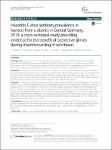Hepatitis E virus antibody prevalence in hunters from a district in Central Germany, 2013: a cross-sectional study providing evidence for the benefit of protective gloves during disembowelling of wild boars
Schielke, Anika
Ibrahim, V.
Czogiel, Irina
Faber, Mirko
Schrader, C.
Dremsek, P.
Ulrich, R. G.
Johne, Reimar
Background: In Germany, 17 % of the general human population have antibodies to hepatitis E virus (HEV) (recomLine HEV-IgG/IgM immunoassay [Mikrogen GmbH]). Wild boars represent an animal reservoir for HEV genotype 3, which is the common genotype in Germany. We estimated the seroprevalence among hunters with contact to wild boars to identify factors that may be associated with past or present HEV infection. Methods: In 2013, the local veterinarian authority in a district in Central Germany attended meetings of hunters who provided blood specimens and completed a questionnaire collecting information on age, sex, hunting-related activities and consumption of wild boar meat. Specimens of wild boars were taken during drive hunts in this district during the season 2012/2013. All specimens were tested for HEV RNA and anti-HEV IgM and IgG antibodies. Log-binomial regression was used to estimate prevalence ratios (PR) for the hunters. Results: Of 126 hunters (median age 55; 94 % male) 21 % tested positive for anti-HEV IgG antibodies (95 % confidence interval [CI] 13–28 %) (recomWell HEV IgG assay [Mikrogen GmbH]). Anti-HEV prevalence was highest in the age group of the 70–79-year-olds (67 %; 95 % CI 39–95 %). Wild boars showed an average anti-HEV prevalence of 41 %. HEV RNA was detected in 4/22 (18 %) liver specimens and in 1/22 (4.5 %) muscle specimens. Most wild boars were tested positive for HEV RNA (3/10; 30 %) and HEV-specific antibodies (7/15; 47 %) in the southwestern part of the district. Hunters preferring this hunting ground had a lower anti-HEV prevalence when gloves were frequently used during disembowelling of wild boars compared to hunters using gloves never or infrequently (age-adjusted PR 0.12; 95 % CI 0.02–0.86). Conclusions: Hunters may benefit from wearing gloves when in contact with blood or body fluids of HEV animal reservoirs. Anti-HEV prevalence among the hunters of this study did not significantly differ from that of the general population suggesting that other factors play a major role in the epidemiology of HEV in Germany.
No license information

